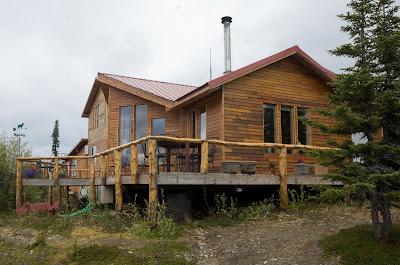
June 16, 2009
The rivers in southwest Alaska are famous for their rainbow trout which can grow to well over 24" in length. They are highly protected game fish. Guides are required to attend certification classes and all anglers are required to use only single barbless hooks on lures when fishing for rainbows. It's practically a capital offense to keep or kill a rainbow - only catch and release is allowed in Alaska.
It was early in the season at the Royal Wolf Lodge and we were graciously offered a small cabin where we could stay and visit with Kate and Kev for a few days and go fishing for rainbows if we liked. This was more than we'd expected and we were touched by Chris & Linda's hospitality.
In the morning we suited up with hip waders, felt-soled boots and warm jackets and were paired up with Tyler for a day of dry fly fishing. We met Kevin by the lake and he flew us out to a little river about 10 miles to the east where Chris owned the land and kept a few boats onshore.
Despite our layers of warm clothes the water was frigid. This early in the season, the rivers and lakes had only recently cleared of ice and the water was running cold. This also meant that the fish were just warming up and they were hungry.
That being said, these are also Alaskan Rainbows we're talking about. These are fish that have been around for some time. They've seen plenty of anglers come and go, they've been caught and released for years. Which means they've had the time to develop discerning tastes. Not just any ol' cast with a tasty lookin lure will do for these fish. No, they want to be convinced. So the first hour or so was taken up with a little instruction on casting the 2" dry flies that we'd be using throughout the day.
I'd never cast a fly in my life. Growing up, the bulk of my fishing was with nightcrawlers and bobbers. I had a couple of spinners and wasn't averse to spearing a minnow on a hook if I could find one, but for the most part I used low tech wiggly worms. Fly fishing was brand new to me. With Tyler's help I moved fairly quickly from completely hopeless (tangled up in floating line) to moderately ok. And then I got lucky and caught the biggest rainbow trout I'd ever seen!

Mark pulled in a respectable 18" rainbow shortly after...

And then he fell in the river. To clarify: he was already in the river, we'd moved upstream to a bend and were casting from a gravel shelf into the waters as they sped up rounding the bend. Mark stepped off the shelf and found himself drifting downstream, near-freezing water pouring into his waders. Thankfully Tyler got the boat fired up and was able to fish him out before he turned completely blue and we rushed upstream to get him warmed up immediately.
At the cabin on Big Ku the guys found some dry clothes and put on hot coffee while Mark thawed out in a hot shower. It took a little while but he finally stopped shivering and the color came back to his lips. We settled in to a good lunch that Kate had packed up for us, had some warm drinks and relaxed enough to decide to head back out for some more fishing.

Staying warm and dry in the boat.
The afternoon was a little more like fishing than catching. We reeled in a few rainbows but nothing to equal the morning's catch. Even so, they were far larger than any we'd seen in the Lower 48 (even at Pike Place).
Late in the day Kevin tracked us down on the river and we loaded up to head back to the lodge. Kate had been working on a couple pike the boys had caught. After she got over the teeth and through the slime (we all know that pike are scary ferocious, but on top of that once landed they emit a coat of eely slime - eewwwww!) Kate sliced 'em and diced 'em and fried 'em up. After all that trouble they were amazingly delicious appetizers piping hot upon our return.
After dinner, while Mark spent time tending to one drowned camera I spent some time with Chris Branham going over the charts. Chris gave me excellent tips on navigating across the taiga where there are few distinct landmarks and few good landings. He also gave us resources that might help us if we were to run into trouble (radio frequencies, lodge locations, owner's names, potential fuel stops). Chris has been flying this terrain for ages and following his recommendations I plotted a course to intersect the Aniak River at its headwaters in the Kuskowin Mountains the next day.
As the sun faded towards the horizon we hiked out to Kate and Kevin's cabin for a little wine, a bonfire, and of course s'mores. Kevin's folks were also up that week, and we traded tales of flying and fishing as the sun settled into it's golden nightime glow.














































